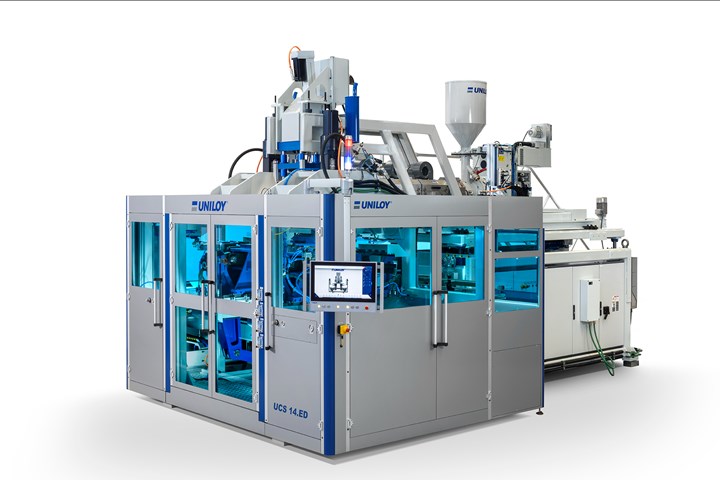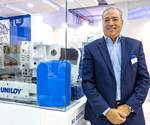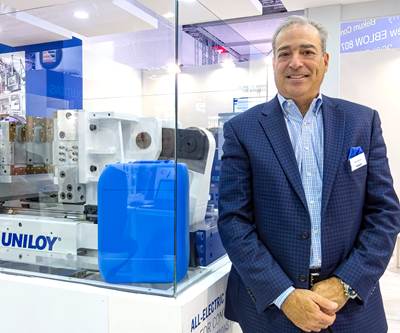New-Generation All-Electric Shuttle Is ‘Industry 4.0-Ready’
Uniloy’s third-generation electric shuttle is designed for versatility and data connectivity.

UCS-E third-generation all-electric shuttles from Uniloy come in sizes up to 30 tons and with up to 12 parisons on a side.
Uniloy Inc. has just released the all-electric UCS-E continuous-extrusion shuttle blow molder for bottles, containers and technical parts as small as 50 ml (1.69 oz) to 30 L (7.9 gal). This is the company’s third-generation electric shuttle and is “the most advanced Uniloy shuttle machine to date,” according to product manager Daniel Horecica-Csiki. He adds, “Key goals in developing this machine were to reduce lead times, reduce maintenance requirements, reduce energy consumption, and achieve an even smaller footprint.”
Introducing “the most advanced Uniloy shuttle machine to date.”
Its electric drives are said to use 40% less energy than standard hydraulic machines, achieving 0.27 kWh/kg of plastic extruded (compliant with Euromap efficiency Class 10). Now standard, its latest-generation, zero-backlash precision gearbox, driven by an AC brushless actuator with an absolute encoder ensures very high repeatability.
A completely redesigned user interface features intuitive guidelines for operators and SPC monitoring. With a 21.5-in. touchscreen that accepts gesture commands like smartphones and tablets, it’s said to allow for speedier setup and numerous customizations. Connectivity and data were at the forefront of this machine’s development, making it “Industry 4.0-ready” and allowing for data exchange with factory-management systems. It incorporates the OPC UA communications protocol that is currently considered the backbone of Industry 4.0 systems. This feature allows for the molding machine to manage downstream equipment such as trimmers and leak testers, notes Horecica-Csiki. The new Uniloy-developed controller also offers remote assistance and diagnostics, and preventive-maintenance and self-diagnostic functions are in development for introduction next year.

All-new controls and interface accept gesture commands and incorporate OPC UA connectivity for data transfer and integration of downstream equipment.
The UCS-E double-sided shuttle is currently available with up to 30-ton clamp capacity and as many as 12 parisons on each side. “We are continuing to develop new models,” says director of European sales Corrado Zanga. Modular machine structure allows for various configurations and adding side stations without space limitations. Users can choose among a wide range of clamping force, stroke and neck cutting force. Overall design is said to be compact, without compromising easy access for maintenance, which is said to be easier than ever. Fewer spare parts are required, as well. These electric machines are described as “cleanroom-ready” and an aseptic upgrade option is available.
Uniloy is developing heads for coextrusion and processing PCR and biomaterials.
As with the previous generation of Uniloy shuttles, the new UCS-E versions incorporate provisions for quick changeovers of blow-pin holders and cassettes. In addition, a new feature is quick-release mold-holder plates that operate by a lever mechanism that eliminates need for tools to unbolt molds.

Quick-change features include special blow-pin holders and cassettes, as well as new quick-release mold-holder plates that require no tools to remove molds.
Uniloy builds its own heads for monolayer applications—optimized for quick color changes—and uses W. Müller heads for coextrusion of up to seven layers. “We are also working on our own multilayer heads,” adds Brian Marston, Uniloy president and CEO. “We are also developing heads for improved processing of post-consumer recycle (PCR) and biomaterials.” The latter, he notes, are more sensitive to process than standard resins and therefore would benefit from equipment designs that provide a wide process window.
More news to come
“We’ve had more product development in the past year and a half as an independent Uniloy than the brand had in the past two decades,” states Marston. He notes that the new controls and interface on the UCS-E are now standard on all Uniloy machines, and adds that new generations of injection-blow and reciprocating-screw machines with “significant new technology” are slated to debut by the end of this year.
Marston also calls attention to the expected completion this year of the Uniloy University lab at company headquarters in Tecumseh, Mich. He says it will be “the only lab in the world” to make three different blow molding processes—injection-blow, reciprocating-screw and continuous-extrusion shuttle—available for testing and training. “Our mold shop is there, too.”
The new UCS-E shuttle is available for demonstration and testing in both Tecumseh and Magenta, Italy.
Related Content
Processing Megatrends Drive New Product Developments at NPE2024
It’s all about sustainability and the circular economy, and it will be on display in Orlando across all the major processes. But there will be plenty to see in automation, AI and machine learning as well.
Read MoreHow to Extrusion Blow Mold PHA/PLA Blends
You need to pay attention to the inherent characteristics of biopolymers PHA/PLA materials when setting process parameters to realize better and more consistent outcomes.
Read MoreCoca-Cola Europacific Transitions to Tethered Caps and Lighter PET Bottle
Sidel is converting all Coca-Cola PET bottling lines in Europe to meet new EU packaging regulations by July 2024.
Read MoreAt NPE, Cypet to Show Latest Achievements in Large PET Containers
Maker of one-stage ISBM machines will show off new sizes and styles of handled and stackable PET containers, including novel interlocking products.
Read MoreRead Next
The New Uniloy Plans Numerous Machine Developments
Starting with barrier coinjection at K 2019, Uniloy plans new blow molding machinery developments across four product lines.
Read MoreUniloy Completes Separation from Milacron
Brian Marston remains in charge of the new Uniloy, Inc.
Read MoreLead the Conversation, Change the Conversation
Coverage of single-use plastics can be both misleading and demoralizing. Here are 10 tips for changing the perception of the plastics industry at your company and in your community.
Read More






















